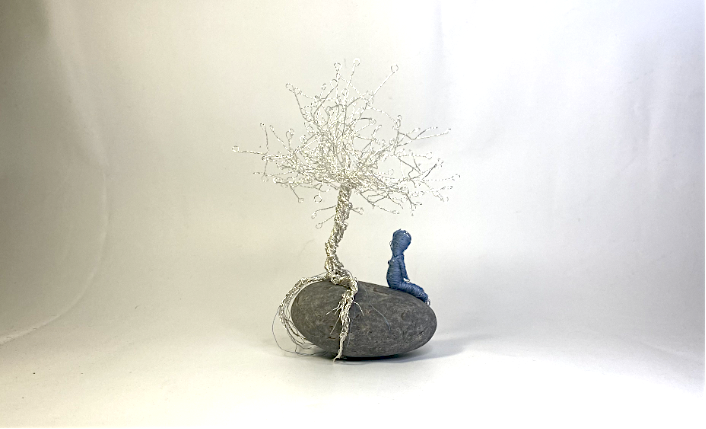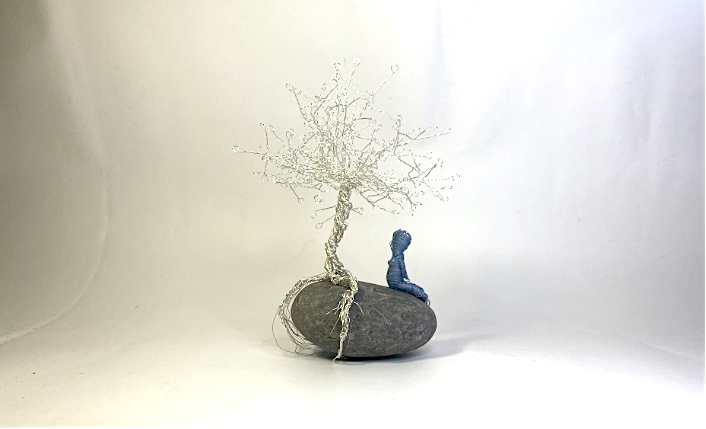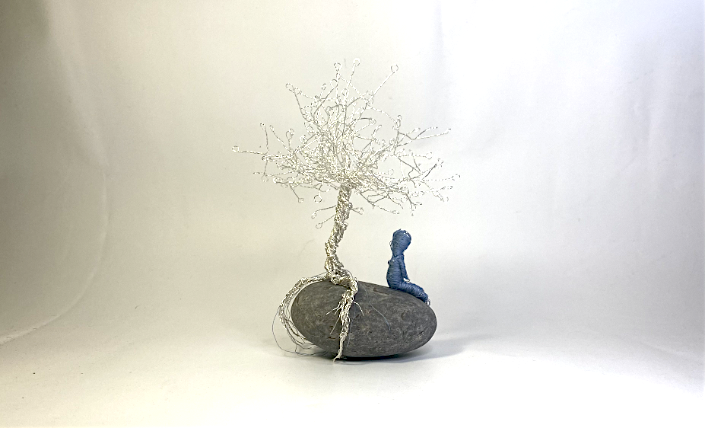The dynamic of familial care
My creative piece is inspired by a GP session where we spoke to a patient with osteoporosis and her daughter, who was the patient’s main caregiver. This encounter challenged my preconceptions of what it means to be a carer, and I left the session feeling moved by their compassionate and resilient relationship.
I was particularly impacted when I asked the daughter how their relationship had changed since her mother’s diagnosis. Expecting to hear about the more negative experiences given everything they had been through, it took me by surprise when instead she poignantly answered; ‘We have become even closer, we are like best friends’. This inspired me to explore the contradiction between the joys of caring for someone you love and the challenges and pressures of being a carer in a world which provides little support.
The tree I created out of silver wire is reflective of the mother and daughter’s developing relationship, but could also be viewed as the illness or the disability – the grounding object bonding them both together. I chose to create a tree as it is suggestive of resilience and growth, qualities the daughter and mother embodied. The daughter shared the challenges of being a carer, with frequent feelings of guilt, burnout and anger. Similarly, the mother, after experiencing several falls, often felt hopeless and frustrated. There were also more complex relations at play – the shifting of familial roles, the religious and cultural expectations, all of which took time for the mother and daughter to adjust to. It was clear that they relied on one another for support and over the years had developed coping strategies. I feel the tree symbolically reflects their strength and I was incredibly inspired by their determination and the way in which the daughter advocated for her mother whilst respecting her autonomy.
The daughter also spoke about how she had missed many life opportunities because of the physical and mental demands of her caring role. For this reason, I chose to include subtle blue threads interwoven in the tree’s roots; Combining the same materials for both the tree and the person, I wanted to emphasise the merging of identities and the way the daughter’s life has become engrossed around her caring duties. The blue figure is intentionally ambiguous to reflect the universal experience of carers, but also to convey the lack of understanding and support carers receive from wider society, often rendering them voiceless, invisible and isolated.
This patient encounter also encouraged me to further reflect on my attitudes towards carers in my own life. It inspired me to have more open conversations with my parents, who are both primary carers for my twin brother who is disabled. It also made me question the label of ‘carer’; as often is the case with unpaid carers, they are first and foremost a mother, a father, a sister, a brother, a friend, a neighbour. Similarly, the daughter did not claim this label, instead believing that she was just doing what any daughter would do. Her commitment affirmed the importance of continuing to humanise carers and value them as individuals, which I hope will enable me to better support and uplift carers in the future.
Highly Commended for the Year One Effective Consulting Creative Prize, 2021
2 Comments
Submit a Comment



I like the way this art piece depicts the caring relationship between the daughter and the mother. The imagery of the tree shows the resilience and age of the mother as she battles with osteoporosis for many years. The way the tree continues to hover over the daughter, providing shelter and comfort, is a great way to show how the mother’s condition doesn’t affect her natural instinct to still care for her child despite the daughter having to do most things for her now. The rock notably symbolises the hard times that both the mother and daughter have experienced and shared. The distance between them as they both sit on opposite ends of the rock it highlights the different hardships that they faced of being the care giver and the patient but still share these difficulties and face these experiences with each other. This piece is modest but the smallest details have great symbolism.
Despite being a relatively small, and indeed seemingly relatively simple piece, this artwork powerfully depicts the ever-evolving relationship between a mother and her daughter when the latter has been placed in the role of caregiver. Through the medium of mixed material sculpture, the student highlights the complex experiences following a diagnosis of osteoporosis that are shared by both individuals, and how they have impacted each of them in differing ways.
Upon first inspection of the piece, it is arguably the silver tree, with its yearning branches and deep-set roots that first catches a viewer’s eye. Interestingly, the tree can offer a form of dual perspective on the impact of illness or caring duties on the relationship; the roots initially appear to be encroaching on the two individuals, given their widespread and firmly bundled nature, suggesting that their rigid grip has had a significant impact on the opportunities and freedom that is able to be experienced by mother and daughter. Notably the tree is larger than both of the individuals, and the subsequent slight shadowing effect suggests that the mother’s condition is ever present and virtually unforgettable / unavoidable within daily lives and conversations. However, the silver colour of the tree offers an alternative view of the situation – with silver being associated with the moon and strong feminine energy and strength, the large tree may also symbolise the determination and strength of both individuals and how this has grown with time as both have come to terms with the diagnosis and adapted to the condition’s effects. It also highlights the unique mother-daughter relationship, and underscores the suggestion that the individuals in question are people, women, specifically mother and daughter who have been affected by osteoporosis, and not merely patient and caregiver. Of course, the silver may well be representative of the bones of the mother during her condition, a stark brittle contrast to the rock below, yet it may also be suggestive of reflection and hope, as the shiny nature of the colour is able to illuminate the way forward upon reflecting light or indeed, hope present.
The interwoven nature of the tree and the blue figure has effectively shown the impact of the condition of the daughter’s life – whilst it hasn’t taken her over completely, her identity is still very much rooted / connected to her caring duties. In this way she is also tethered to her mother, who is arguably represented by the rock. It is possible to suggest that the rock in this piece is representative of the difficult situations the mother and daughter have faced together, yet it seems to me that the rock is in fact the mother herself. Many people describe their parents as their “rocks” – people to be relied on for advice or help, and this doesn’t necessarily change when a parent has a severe condition. The relatively small blue figure sits on the rock, and whilst appearing to be isolated from any other features remains intimately connected to the rock.